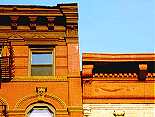N E I G H B O R S A S S O C I A T I O N ( L I N A )
h i s t o r i c a l a r c h i t e c t u r e
Little Italy contains a number of buildings of architectural and historical interest. A 1974 study identified forty-one local buildings that the Department of City Planning found of historical merit, including some of landmark quality.
To date, nine buildings in the area have been designated as landmarks by the New York City Landmarks Preservation Commission. All but two of these have also been listed with the National Register of Historic Places (the nation's official list of cultural resources worthy of preservation).

![]() Twenty-two local buildings, including many of the landmarked buildings, have been deemed "Buildings of Special Significance" under the NYC Zoning Resolution. Finding that the buildings "are unique either because they are socially or traditionally significant or because they are important physical influences in the life and image of the community," the zoning resolution bars the demolition of such buildings unless they are unsafe, or unless the City Planning Commission issues a special permit allowing the demolition to proceed. The permit may be granted only if the commission finds that the building cannot be rehabilitated. Alterations to the exteriors of such buildings involve a similar permit, which is only granted if the commission finds that the proposed alteration "relates harmoniously to the character and materials of the original facade and of adjoining buildings."
Twenty-two local buildings, including many of the landmarked buildings, have been deemed "Buildings of Special Significance" under the NYC Zoning Resolution. Finding that the buildings "are unique either because they are socially or traditionally significant or because they are important physical influences in the life and image of the community," the zoning resolution bars the demolition of such buildings unless they are unsafe, or unless the City Planning Commission issues a special permit allowing the demolition to proceed. The permit may be granted only if the commission finds that the building cannot be rehabilitated. Alterations to the exteriors of such buildings involve a similar permit, which is only granted if the commission finds that the proposed alteration "relates harmoniously to the character and materials of the original facade and of adjoining buildings."
Below are the buildings that have been singled out as notable, along with a few more we like:
Bowery Savings Bank, 130 Bowery (at Grand). Built 1893-95. Designed by Stanford White in the Roman classical style, with corinthian columns and a marble mosaic floor. (NYCLPC) (NRHP, 4/23/80).
Church of the Most Precious Blood, 113 Baxter Street (between Canal and Hester). (BSS).
Federal-style house (former Stephen Van Rensselaer house) at 149 Mulberry Street (just south of Grand). Built around 1816. This wood frame house was originally located on the other side of Grand Street, but was moved. As is typical of the oldest buildings in the area, it has a pair of dormer windows. (NYCLPC)
Fire Station No. 55, 363 Broome Street (between Mott and Elizabeth). (BSS). Ferris Provision House, 262-72 Mott Street (between Prince and Houston). Five-story loft. (BSS).
Former 11th Police Precinct, 201-05 Mulberry Street (between Kenmare and Spring). Five-story building. (BSS).
Former Hook & Ladder No. 9, 209 Elizabeth Street (between Spring and Prince). Three-story loft; now part of a bakery. (BSS).

![]() Former Police Headquarters Building, 240 Centre Street (taking up the entire block between Grand and Broome). Designed by the firm of Hoppin & Koen in an exuberant Edwardian Baroque style, it opened in 1909. The police moved out in 1973 and the building was converted to luxury condominums in 1987. (BSS) (NYCLPC) (NRHP, 3/28/80).
Former Police Headquarters Building, 240 Centre Street (taking up the entire block between Grand and Broome). Designed by the firm of Hoppin & Koen in an exuberant Edwardian Baroque style, it opened in 1909. The police moved out in 1973 and the building was converted to luxury condominums in 1987. (BSS) (NYCLPC) (NRHP, 3/28/80).
Former Y.M.C.A Building (aka the Bunker), 222 Bowery (between Prince and Spring). Built 1884. Designed by architect Bradford L. Gilbert in the Queen Anne style, with arched windows and irregular details. One of the most interesting buildings in the area, culturally as well as architecturally. Painter Fernand Leger lived there in 1940 and 1941; writer William S. Burroughs kept an apartment there from 1974 until his death in 1997; Mark Rothko also lived there for a time. (NYCLPC).
Fourteenth Ward Industrial School of the Children's Aid Society, 256-58 Mott Street (between Prince and Houston). Built 1888-89 in the Victorian Gothic style, decorated with terra cotta ornamentation. (BSS) (NYCLPC) (NRHP, 1/27/83).
![]()
![]()